by franz
DAY 1: ARRIVAL IN ANTANANARIVO
Arrival in Tana, meet and greet upon arrival in the capital of Madagascar. Then, transfer to your hotel which is near the airport. If the time of arrival will permit, excursion to Alarobia lake, a Ramsar site which is situated around 10 km from the hotel, within the city limits of Antananarivo. This site is your first introduction to some of the commoner Malagasy birds, with a spectacular heronry. This is a refuge mostly for Cattle Egrets and a ruined summer house of royalty long deposed.
At the end of the afternoon, we head back to the hotel GASSY COUNTRY HOUSE for spending the night, on B&B.
DAY 2: TANA – FORT-DAUPHIN (Domestic Flight) – BERENTY: 80km – 4hours drive
After breakfast, transfer to the airport for the flight to Fort-Dauphin. After landing, we head to Berenty. We drive along the humid forest of the east, the landscape will be decorated with rice fields, green and luxuriant vegetation, many palms and mangoes trees. Few kilometres ahead, we pass the Anosy Mountain chain then we arrive to the “transition zone” dominated by the triangular palm “Neodypsis Decari”, an endemic palm to Fort-Dauphin. From here the landscape is changing to dryer vegetation. Berenty reserve is situated 80 km west of Taolagnaro and 6 km north of the village of Amboasary. Berenty is an active sisal estate, a part of which has been conserved in its original state by the de Heaulme family. The habitat comprises spiny forest, frontage onto the Mandrare River, and most importantly, a 100 hectare patch of deciduous gallery forest that contains excellent walking tracks. Arrival in Berenty by the end of afternoon. Night in BERENTY LODGE on HB.
DAY 3: BERENTY
At dawn, a birding expedition with a special guide at 05.30 inside Berenty Private Reserve, where 83 bird species are listed. Birds of prey are particularly prominent and 9 species are recorded with Madagascar Buzzard probably the more common raptor around. Other unique Madagascar species that can be seen include Hook-Billed Vanga and Crested and Giant Coua. 6 species of Vanga exists here of which Lefresnaye’s Vanga is the most sought after the Vanga. The forest is divided into 2 parcels: the spiny forest and the gallery, semi-dry forest. Sisal plantations surround the reserve. After lunch, guest can by themselves in the reserve. Berenty is one of main reserve where one can see almost all the fauna and flora of the South. It is also known as the kingdom of lemur such as the ring-tailed lemurs known as Maki and the dancing lemurs known as Sifaka. The other species is brown lemurs and for nocturnal, we can see lepilemurs, mouse lemurs. By 05.30pm, night expedition to explore the reserve and to look for night active animals. Night in BERENTY LODGE on HB
DAY 4 : BERENTY – FORT DAUPHIN
Another bird watching expedition at dawn near the Mandrare river. Then have another expedition inside the reserve after breakfast. Around noon, we drive to Fort-Dauphin. Overnight in Croix du Sud on half board
DAY 5 : FORT DAUPHIN – TULEAR (Domestic Flight) – IFATY
Transfer to the airport and take the domestic flight to Tulear, and have 1 hour drive to Ifaty, a beach resort which is a popular place for birders. Mangily is a small village just to the north. This is a large area of the famous spiny forest, where the landscape of Baobab, Octupus trees and Euphorbias is so weird and wonderful that you might as well be walking on a different planet. This area is loaded with extravagant semi-desert endemics. Because of the heat, we will only visit the Reniala Park by the end of afternoon, where most of the birds endemic to the southern sub-desert are found. We can see the White-Headed, Hook-Billed & Lefresney’s Vanga, Long Tailed-Ground Roller, Archbold’s Newtonia and If we are really lucky, the Subdesert Mesite. The excursion also gives us the opportunity to see reptiles like Boa, Geckos, Lizards and the biggest Chameleon in Madagascar. Overnight in Hotel LA MIRA on BB
DAY 6 : IFATY – SAINT-AUGUSTIN – ANAKAO: 36 km: 1 hour drive and 1 hour boat transfer
At dawn another birding expedition around the hotel grounds, where many birds can be spotted, including lesser Vasa Parrot, Madagascar Lark, Madagascar Cisticola Green Capped-Coua, Sub –Desert Brush Warbler and the only endemic Wader- Madagascar Plover. Then 1 hour drive to Saint-Augustin, where we might spot some pink flamingos and other birds before taking the boat to transfer us to the pretty fishing village of Anakao. Littoral Rock Thrush is found in the dune vegetation in the Anakao hinterland, but also in the village itself. Arrival by noon.
Overnight in hotel ANAKAO OCEAN LODGE or similar, on B&B.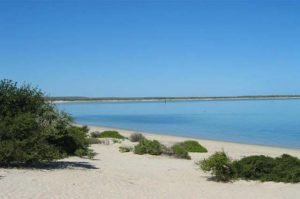
DAY 7: ANAKAO – EXCURSION TO NOSY VE ISLAND
At dawn, birding in Anakao then boat transfer to Nosy Ve which is a small sandy island, opposite Anakao, situated about 4.5 km offshore. It has approximately 75 pairs of nesting Red-tailed Tropicbirds. This exotic and scared islet is home to Greater & Lesser Frigatebird, Red-tailed Tropicbird, Ruddy Turnstone, Sanderling, Crab Plover, Grey Plover, White-fronted Plover, Caspian Tern, Lesser Crested Tern, Roseate Tern, Saunders’ Tern and Bridled Tern.
Overnight in the same hotel ANAKAO OCEAN LODGE or similar, on B&B.
DAY 8: ANAKAO – ST AUGUSTIN – TULEAR (45 mn by boat) – ISALO: 234 km – 4hours drive
After breakfast, boat transfer to St Augustin, where the car is waiting for us to drive to Isalo. The scrub that grows on the eroded coral ‘rags’ alongside the road to Baie de St. Augustin, at the mouth of the Onilahy river, supports the highly localised Verreaux’s Coua and Littoral Rock-Thrush. Also many other species can be seen there.
St. Augustin is full of history, and was the site of pirates. A few bird species along the road also at the Plateau of la table we can find other marine and terrestrial species. Afterwards, we take the National 7 which links Tuléar to the capital. Our first step is to Isalo, 4 hours’ drive from there. On the way we will see different colourful tombs: those of ”Mahafaly” and “Antadroy”. Few kilometres ahead, in Andranomaintso, we pass through the plateaux of baobab “Andansonia Za” a unique species to Madagascar. We stop in Zombitse National Park, which hosts many birding wonders, where the highlight is the very rare ‘terrestrial’ Appert’s Greenbul, probably one of Madagascar’s rarest endemics. This highly threatened species is restricted to two tiny forest patches in the world; Zombitse being one of them. One can also find Henst’s Goshawk, Giant Coua, Coquerel’s Coua, Rufous Vanga and White-browed Owl.
Afterwards we pass finally Ilakaka, the sapphire mining town before we arrive in Ranohira, our today’s destination. Overnight in RELAIS DE LA REINE on HB
DAY 9: ISALO
After breakfast we visit Isalo National Park. Covering a massive area 81 504 ha, the Isalo Massif rises from the flat surrounding grassy plains. The scenery cunningly reminds us of the Fishriver Canyon in Namibia or the great Canyon in the USA. After reaching the top of the mountain, a fantastic panoramic view of the eroded mountain with its different colours starting from yellow to red sometimes grey. The sandstone has been eroded into strange shapes, cut through by impressive gorges and canyons. Vegetation is concentrated in the canyon bottoms where streams flow. These wooded areas dominated by the fire-resistant Tapia-tree, on which a Malagasy endemic silkworm feeds. On the cliffs and rocks are several endemic succulents including the elephant’s foot and the localised endemic Isalo Aloe. This is also a place where the Bara tribe put their dead while saving money to buy silver coffins and the bodies in a safe place! After visiting the natural swimming pool, we continue on foot to reach “the Canyon des Singes”.
Isalo is not a place with high numbers of birds,but we can spot Benson’s Rock- Trush, sub-species of the forest Rock-Trush , in the oasis and forest around Relais de la Reine. Other birds that might be encountered include Lesser Vasa Parrot, White –Throated Rail, Madagascar Coucal, Madagascar Wagtail and Madagascar Kestrel. At the end of the afternoon, we visit Fenetre de l’Isalo, a natural rock formation having the shape of the window. Overnight in RELAIS DE LA REINE on HB
 |
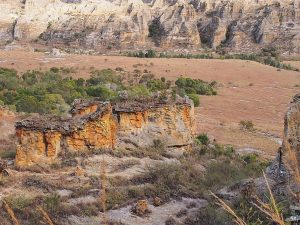
|

|
DAY 10 : ISALO – RANOMAFANA: 285km – 7hours drive
Morning, we head on to Ranomafana, our today’s destination. We’ll drive through the huge «plateaux de Horombe” with its very spacious red soil which reminds us of “the noman’s land” there arrive in Ihosy the capital of Bara tribes, the sheperds of Zebu. We cross the mountain chain of Andrigitra, with “ “the gate of the south”, a spectacular huge granite dome with twin rock towers. The other most imposing one is the “bishop’s hat” which is a sacred place for the local people. Before Ambalavao, we visit the village run park Anja, well known for its lemur Catta, caves and reptiles. We can also visit “Antemoro Paper”, a tradition left by the Arabian people settling in this area in the fifteenth century. After a short city tours of Fianarantsoa, we head on to Ranomafana. After a couple of kilometres, we stop at a little pond where we have a quick scan of for the Malagasy King Fisher and Crested Drongo.
From here we can also take a walk along the road to admire the wet tropical forest to get the blood flowing again after the long drive. Arrival in Ranomafana, check-in and overnight in CENTREST SEJOUR or similar, on B&B.
DAY 11: RANOMAFANA National Park
At dawn, with a special birdwatcher guide, we’ll have 2 hours expedition in the park for bird watching, searching for some endemic Madagascar bird species. Back to our hotel for breakfast. At around 08.00, we have another hike in the park to explore different parts. We might see the Greater Bamboo Lemurs and the striking Milne-Edwards Diadema Sifaka Lemur.
Continue to VOHIPARARA which is 15 km from Ranomafana. This is at higher elevation and better for a few bird species (Pollens Vanga; Common Sunbird-Asity; Yellow-browed Oxylabes). The bird list for the area is long, and contains an impressive number of endemic species.
By evening, a night walks along the main road, where we might spot some birds and lemurs. Overnight at the same hotel CENTREST SEJOUR or similar, on B&B.
DAY 12: RANOMAFANA – AMBOSITRA – ANTSIRABE: 260km – 7hours drive
After breakfast, we head on to Antsirabe. We drive through Ambositra, the centre of Madagascar ‘s wood carving industry .The architecture of the area is stunning, as all houses express ornately carved wooden balconies and colourful shutters, leaving us an impressive artworks behind us. We drive the “le col de tapia”, a type of tree resistant to bush fire. We will arrive at destination at the end of the afternoon, Antsirabe or ”the place of Salt”, is an elegant city, known as the centre of beer. Founded by Norwegian in 1856, it is the only place which really feels and looks like a European city. It has a temperate climate and all fruits and vegetable which grow in the cold climate are found here. Check in at hotel ROYAL PALACE or similar, on B&B.
DAY 13: ANTSIRABE – ANDASIBE: 305 km – 6 hours drive
After breakfast we drive to Tana. The route we are travelling takes us across the “highland landscape” with impressive rice-fields and spectacular eroded hills called “lavaka”. The landscape reminds us of the Far East with its rice fields and green landscapes covered with vegetable and fruit plantations. We stop in Ambatolampy, n agricultural city also known for its aluminium transformation and handwork. Arrival in Tana, the terminal of RN7 and we take a short cut to reach the RN2 which links the capital to the east, towards Andasibe. The area around Andasibe is well-known for its prime forests and lakes as well as the humid conditions. En route we might see Yellow-billed Kites and Madagascar Kestrels. We make a brief stop at the Mangoro Bridge just before Moramanga. A number of birds of the”rainforest specials” and spectacled Greebulb and Nelicourvi Weaver might be seen. Arrival in Andasibe, we check in at the hotel VAKONA FOREST LODGE or similar, on B&B. Then, a night walk along the main road on the foot of Andasibe forest should reveal a wide variety of nocturnal lemurs, reptiles, frogs and fascination.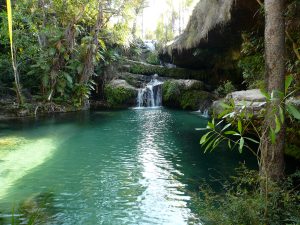
DAY 14: ANDASIBE: Mantadia National Park
Full day expedition in Mantadia National Park for Bird watching.
Madagascar little grebe, Cuvier’s Rail, Madagascar spine tail, short-legged ground roller, scalyu ground-roller, Pitta-like ground-roller, Cryptic Warbler, Whiote-headed Vanga, Tylas Vanga are to be found there. Overnight at the same hotel on B&B.
DAY 15: ANDASIBE NATIONAL PARK – TANA: 145km – 4hours drive
Up at a daybreak for birding in Andasibe (perinet). Andasibe is an excellent example of montane rainforest and covers an area of 810 ha at an altitude between 930 and 1.040 m. Many largest trees have been removed and the canopy averages 25 to 30 m. The main part of the reserve resembles a table, with steep forested hillsides (with steps to make it easier for us human beings) and bordered by a small lake. Early morning birding can be very successful in this lovely stretch of Mountain rain forest. We return to our hotel for breakfast after which we visit the special reserve of Andasibe. Analamazaotra special reserve is popularly known by the old French name of the nearby town and railway station- Périnet or Andasibe. The elevation is lower than Ranomafana, but the two bird lists have many overlaps. More than 100 resident species have been recorded, including more than 60 endemics, and a fine selection of lemurs.
The main attraction is the Indri, the world’s largest lemur, a magnificent creature that sits in trees in family groups and utters ear splitting moans and wails. Small insectivores include Greater Hedgehog Tenrec and Lowland Streaked Tenrec.
After lunch, we drive back to Tana through the winding road of the National 2. Green landscape, composed with tropical rainforest, alternated with eucalyptus and pine, hills, valleys, lakes and rivers, villages with huts, bricked house with thatched roof are the scenery we will see along the way. Overnight in GASSY COUNTRY HOUSE, on B&B.
DAY 16: TANA – MAJUNGA – AMPIJOROA: 120KM – 2Hours drive
Early in the morning, transfer to the airport for the flight to Majunga. Arrival in Majunga and drive straight to Ankarafantsika which is situated at 120 km from Majunga. This drive take 2 hours from Majunga. The landscape is composed with a huge plain of ricefields; cassava’s plantation and corn. On the way stop at the Lake Amboromalandy which is a very obvious impoundment on the main road between Majunga and Ampijoroa. It is 95 km from Majunga and 25 km from Ampijoroa. This large man-made impoundment is a great stop if you have time to kill. The lake is worth about 2 hours, the pools and puddles before and after the lake may hold a few species like Purple, Striated, Common Squacco and Malagasy Pond herons and so on… and very occasionally African Open-bill Stork may be seen. During our night walk, we could spot Tortoroka Scops Owls near the campsite and Madagascar Nightjars. Overnight in AMPIJOROA LODGE or similar, on B&B.
DAY 17: AMPIJOROA – MAJUNGA
Early morning exploring the trails around the magical Lake Ravelobe. One of the key features of the Lake is one pair of the critically endangered Madagascar Fish Eagle. With an estimated 50-100 breeding pairs remaining in the wild, this bird is on the edge of extinction as is classified as endangered by Bird Life International. While it is exhilarating to see such a rare bird, it is equally sad to know it is disappearing so suddenly. Other residents on the lake are also to be seen there.
The crocodiles in Lake Ravelobe are protected by fady and have been known to attack unsuspecting villagers.
After breakfast we will explore the natural treasures of Ankarafantsika. The terrain here is quite flat so today’s walk will not be too challenging. Also, Ankarafantsika National Park is known to be one of the largest remaining dry deciduous forests, and forms a mosaic with extensive wetlands and provides the final refuge for numerous critically endangered and endemic species including lemurs, reptiles and birds. By the end of the afternoon, drive to Majunga and enjoy a sunset in the picturesque Cirque Rouge, 45 minutes from central Majunga, which has a pair of breeding Peregrine Falcons.. Overnight in hotel Coco Lodge, on B&B.
DAY 18: MAJUNGA – DELTA OF BETSIBOKA – TANA
At dawn, transfer to the harbour to take the boat to the Delta of Betsiboka. From the boat clubs in Majunga, it takes about 1.5 hrs to steam up the river and into the mangroves at Betsiboka. At high tide the specialty birds are roosting in the mangrove islands and both Madagascar White Ibis and Bernier’s Teal can be found on several islands in the river mouth.
Transfer to Majunga airport to fly back to Tana. Transfer to hotel. Overnight at the hotel GASSY COUNTRY HOUSE, on B&B.
DAY 19: TANA – ANOTHER DESTINATION
Day off. Transfer to airport in time for your flight. Flight back home.
END OF SERVICE
Recommended Posts
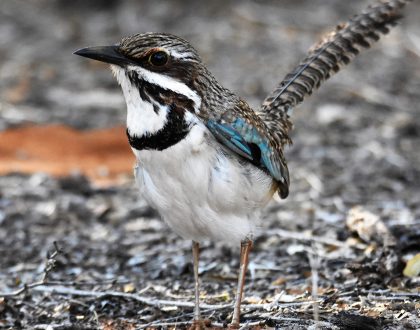
21/ Special interest – Birding tour in Madagascar
August 6, 2018
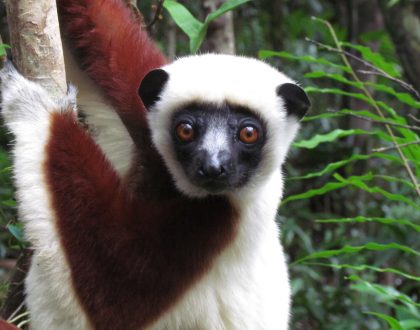
Madagascar Northern Untamed : 14 nights – 15 days
July 17, 2018
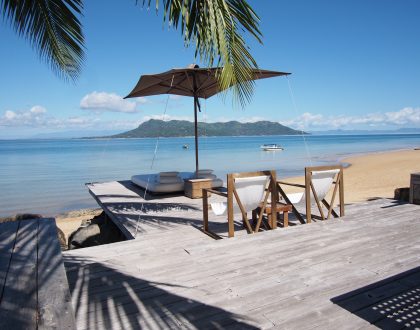
32/ Family tour
May 28, 2018
